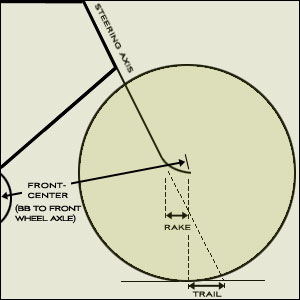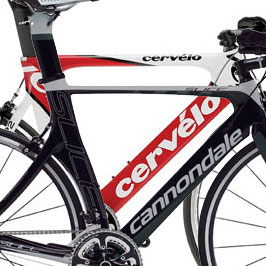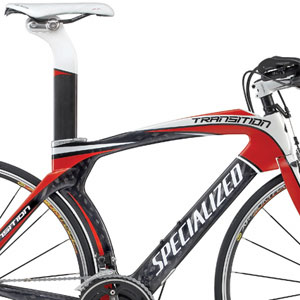Inputs and outputs: Volume 2

I'm going to focus on an arcane element of bike geometry, and spending as much time on it as I intend might seem like majoring in the minors. To that I plead: Guilty with an explanation.
First, the issue is not so arcane; second, I'm hoping to influence not only behavior, but thought processes that attend problem solving.
The subject is a bike's "trail", and I'm going to gently question the decisions of some of our industry's bike designers and product managers.
First, what is trail? The attached graphic explains it. What does trail do? It conspires with several elements to keep all our bikes upright, and to give our bikes a steering and handling theme. The greater the trail, the more stable the bike handles, up to and past the point of optimal stability, and then toward slow and sluggish steering (if the trail is too great).
Reduce the trail and the bike is sprightly and responsive, up to and past the point of optimal quickness and then toward nervousness and unpredictability (if the bike's trail is too small).
What is an optimal range? I think a tri bike is best when trail sits between 59mm and 62mm.
How does trail change? Two ways. You can make a bike's head angle shallower. The bike's steering axis travels through the center of the bike's head tube. Look at the attached diagram, and think where that imaginary line projecting forward from the steering axis would hit the ground if that angle was shallower. It would hit the ground further in front of the tire's contact patch, would it not? That increases trail.
Instead, you could reduce the fork rake, couldn't you? (For the purposes of this discussion, "rake" and "offset" are synonyms.) If you reduced the rake, you'd also add more trail, right? (Ninety percent of folks in the bike industry have this backwards, including too many product managers; they think adding rake makes the bike handle slower, and as you can plainly see from the diagram, it has the opposite effect).
When you alter the bike's rake, and/or it's head angle, you change one more thing: You add or subtract front/center. This is the distance between the bottom bracket axle and the front wheel axle. This is an important metric, because our bikes' steeper seat angles, combined with resting our bodies on the fronts of our bikes, places a lot of weight on the front wheel. This requires tri bikes to have longer front/centers (to place our centers of gravity more in between the wheels, rather than too close to the front wheel).
There is another important element to the front/center measure. On small bikes, if that front/center is not long enough, you'll run into a clearance problem. It's called "shoe overlap," and it's when your shoe threatens to interfere with the back of the front wheel while turning.
Now, with all that as a backdrop—and whether you realize it or not—you're sufficiently equipped to answer this question: What are your inputs when choosing the steering geometry for a bike you're designing? What are your drivers? What is important to you? What's worth preserving?
I ask this against the backdrop of a review I wrote last week of the Specialized Transition Comp. As noted in that review, the XL and XXL sizes have enough front/center to offer their riders a good weight balance, and, the bike's 61mm of trail is identical to Cervelo's tri bikes and close to Cannondale's nice handling 58cm Slice.
But Specialized sticks with the same 43mm-raked fork for its SM, MD and LG sizes as it does with its XL and XXL, but, for these three smaller sizes it shallows the bike's head angle—from 72.5° to 72° for the MD and LG. This increases the trail for these sizes to 65mm. On the SM size, the head angle is shallowed to 71.5°, but that same fork is used, so, the trail increases to 68mm.
The XS size shallows even more, to 69.5° of head angle, but in this size another fork is used, with a rake of 49mm, and this brings the trail back to a more reasonable number.
As these bikes get smaller and smaller in size, the pressure is on bike makers to shallow the head angle, in order to increase the front/center, and stay clear of shoe overlap problems. This pressure is extreme when bike companies make the decision not to run 650c wheels on these smaller sized bikes.
These middle sizes of the Transition—the SM, MD and LG—suffer from a shallowing of the head angle without any corresponding addition in fork rake. What Specialized needs for these SKUs—in my opinion—is a fork with a 46mm rake.
Specialized is not alone, by any means. Scott's Plasma models use a 45mm fork on all its models. The head angles of the largest sizes is 72.5°, and this yields a trail of 60mm or so—which is quite appropriate. The middle sizes use a head angle of 72°, and the trail on these bikes is 62mm. No problem here. The head angles then, however, shallow to 71.5° and then 71°, making the trail 65mm and 68mm respectively. These bikes want forks with larger rakes.
Cannondale is nearly in the same boat. It's five sizes of bikes feature a trail of 62mm in the larger sizes, and 65mm in the two smallest sizes. Fortunately, no models approach 7cm of trail, but 65mm makes the bike a bit of a slow handler.
Why does this matter in triathlon, when the bikes don't need to sprint, and the races feature courses often not placing a high premium on handling? I'll explain.
Even if there are no turns, it's difficult to keep a bike tracking straight and true if the bike is a sluggish handler. When the bike veers from its intended line, the rider's first necessary act is to steer the bike even further from its intended line, so that the rider's center of gravity is in between the tire's contact patch and the intended line. A slow handling bike makes it hard for a rider to execute these maneuvers, so, even on a course that has no turns at all, an over-slow handler is a harder bike to point perfectly straight.
These companies listed above make fine bikes. Their larger sized bikes are unequivocally good handling machines. Their smaller sizes are—in my opinion—less optimized as regards handling, because of two design decisions: 700c wheels used on all sizes; and the lack of forks with rakes that match the head angles used in these smaller sized bikes.
Contrast that with bikes made by QR, Felt, Cervelo and others. These companies make tri bikes that handle identically throughout their size runs, and they all offer 650c wheels in their smaller sizes.
But this doesn't mean that the addition of a 650c wheeled bike in the small size solves the issues. Kestrel offers a 650c in the Airfoil Pro in its smallest size. But the trail changes throughout this bike's size run, decreasing from 64mm (in the smallest size) to 62mm, then to 58mm, 57mm, 56mm and eventually 54mm in this bike's largest size. This, because the head angle increases by a quarter-degree every size, ending in an uncharacteristically (for tri bikes) steep 73.5° head angle, while the fork rake used on every 700c size remains unchanged.
In this case of the Kestrel Airfoil pro, the largest sizes feature quick handling. The handling is not over-quick, by road bike standards. Trek's Madone, for example, features trail quantities that descend from 5.7mm for the 52cm size to 5.5cm for the 62cm size. Specialized Tarmac bikes have trails that descend from 57mm to 53mm from sizes 52cm to 61cm. What Kestrel is doing is using trail numbers that mimic road race bike numbers.
And as we have just seen, road race bikes often do not have constant trail numbers throughout their size runs. But Cervelo does, however, seem to treat trail as an input, both for road and tri—that company's trail is quite steady throughout its size runs.
I called up a couple of the old frame builders who've been making frames since the steel days (these builders still make steel frames). When I started bike racing, custom builders like these made the whole bike, fork and all. The blades were hand bent by the bike builder. It might seem like an arcane, inaccurate way to build bikes, but, those forks had blades more precise, in my experience, than a lot of the carbon forks popping out of molds today. They were also uniformly the best handling bikes I've ever ridden—heavier than the bikes we buy today, but, great handling.
The consensus among the old guys is that trail was an input. This isn't to say that trail was the same for every bike, rather than trail varied based on the bike's job, not the bike's size.
Interestingly, touring bikes meant to carry front panniers tended to be built with slightly less trail than touring bikes not carrying panniers, because the weight on the front of the bike made the bike harder to steer. The steering geometry had to be tuned accordingly. Can you think of any other cycling sub-specialty that features a lot of weight on the front wheel? Hint: You're engaged in that sup-specialty.
(This line of reasoning does provide a narrative that favors the use of the roughly 5.5cm of trail in the tall sizes of Kestrel's Airfoil Pro, so, it's a defensible decision even if that handling is still—in my opinion—on the quick side.)
The upshot is this: Do these bikes—road and tri, but, specifically tri—feature the trail numbers they do because the builders truly believe each of these bikes will handle best with the trail number assigned to them?
Or, do they have these trail numbers because the true drivers are shoe overlap; saving costs on new dropout molds; and inventory simplification, through fewer fork SKUs?
If it's the latter (which is what I suspect), do the designers just think that trail is not important—that riders can get used to anything, including bikes with either 54mm trail or 68mm of trail, as two popular tri bikes listed above feature?
I think trail is a driver. Or if not, it ought to be. When you design a bike, you determine your drivers—your inputs. What remains is the driven—the outputs—and one such output is fork rake. You then build the fork with the rake that grants you the front/center, and the trail, that your bike ought to have.
My message to today's bike builders: You've made wonderful machines. Transitions, Slices, Airfoils, Plasmas, and many others, they're all fabulous bikes. As are the forks that go with them. Each of your bikes fit a good cross section of the populace. And all of your models handle well, but not necessarily throughout the size run. Take a page from the old time bike makers, and make your fork with one more available offset—one that gives riders in sizes 51cm thru 54cm the same good handling available to riders of your larger sizes. (In the case of Kestrel, it would be the converse: make a fork that gives the larger riders the calmer handling available to those riding the smaller sized Airfoil Pros).
Monetarily, it usually does not take an act of god to add a new rake to a fork model (it's often a case of a new dropout mold inserted into an existing fork). So, consider whether trail is the soft underbelly of the otherwise world class bike you're making and, if so, let's get that new fork SKU going!
The larger lesson, for those of you who buy and race these bikes, is: What are your drivers when you decide on a piece of equipment? What are your inputs? Paint scheme? Sex appeal? If so, fine, but, the next time you consider a large purchase, write down your inputs. If it's the cosmetic scheme, fine, just write it down. Then orient your inputs in order of importance.
Whether you're hunting up a bike, a job, a house, a car, a college major, or a spouse, you'll be surprised how your tastes change once you ask yourself: What traits or features are the best match for me? Those traits will soon drive your decisions, not because they'll overcome your desires; rather because they'll become your desires.



